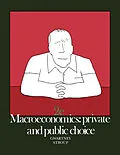Macroeconomics: Private and Public Choice discusses the principle of macroeconomics, particularly government expenditure, taxation, public choice theory, and labor markets. The book also covers aggregate supply, fiscal policy, inflation, unemployment, traditional Keynesian theory, low productivity, rapid inflation. The text explains international economics and comparative systems such as the export-import link, export taxes, and foreign finance. It analyzes the existence of trade barriers as being due to domestic protectionism policies, special interest nature of trade restrictions, and economic illiteracy. The book examines the economics of government failure, namely, the collective decision-making process as being both beneficial and limited of public sector economic action. Among the reasons cited for government failure are voter ignorance, inefficient public policy, existence of special interests, imprecise knowledge of consumer preferences, as well as government shortsightedness. The book also examines why government intervention in some activities can be beneficial, for example, weak market competition or monopoly, uninformed consumers, and when conditions of external benefits can be achieved. Economists, sociologists, professors in economics, or policy makers involved in economic and rural development will find the text valuable.
Inhalt
Preface
Acknowledgments
Part One: The Economic Way of Thinking-An Introduction
Chapter 1 The Economic Approach
What Is Economics About?
The Economic Way of Thinking
Positive Economics
Normative Economics
Pitfalls of Positive Economics
What Do Economists Do?
Outstanding Economist: Adam Smith (1723-1790) and the Historical Roots of Economics
Myths of Economics: "Economic Analysis Assumes that People Act Only Out of Selfish Motives. It Rejects the Humanitarian Side of Humankind."
Chapter 2 Some Tools of the Economist
Opportunity Cost Is the Highest Valued Opportunity Lost
The Production Possibilities Curve
Trade Tips and Comparative Advantage
Three Economizing Decisions Facing All Nations: What, How, and for Whom?
Two Methods of Making Decisions-The Market and Government Planning
Outstanding Economists: David Ricardo (1772-1823) and the Early Followers of Smith
Myths of Economics: "In Exchange, when Someone Gains, Someone Else must Lose. Trading is a Zero-Sum Game."
Chapter 3 Supply, Demand, and the Market Process
Scarcity Necessitates Rationing
Consumer Choice and the Law of Demand
Producer Choice and the Law of Supply
Markets and the Coordination of Supply and Demand
Shifts in Demand and Advice on How to Pass Your First Economics
Exam
Shifts in Supply
Time and the Adjustment Process
Repealing the Laws of Supply and Demand
The Communicating, Coordinating, and Motivating Functions of the Market
Outstanding Economist: Alfred Marshall (1842-1924)
Myths of Economics: "Rent Controls are an Effective Method of Ensuring Adequate Housing at a Price the Poor can Afford."
Chapter 4 A Bird's-Eye View of the Public Sector
Ideal Economic Efficiency
Why Might the Invisible Hand Fail?
Government-A Potential Vehicle for Gain
Redistribution-Dividing the Economic Pie
The Market and the Public Sector-Two Methods of Economic Organization
Conflicts between Good Economics and Good Politics
Outstanding Economist: James Buchanan (1919- )
Chapter 5 Taxes and Government Spending
What Do Federal, State, and Local Governments Buy?
How Big Is Government?
The Growth of Government
Taxes to Pay for a Growing Government
Politics, Tax Incidence, and the Structure of Taxes
Who Pays the Tax Bill?
The Taxes Paid in Other Countries
Taxes and Politics-A Final Word
Myths of Economics: "The Growth of the Federal Government has been the Major Source of Government Expansion."
Part Two: Macroeconomics
Chapter 6 Taking the Nation's Economic Pulse
The Concept of the GNP
The Circular Flow of Expenditures and Resource Costs
Two Ways of Measuring GNP
The Expenditure Approach
The Resource Cost-Income Approach
Gross National Product or Gross National Cost?
Five Problems with GNP as a Measuring Rod
What GNP Does Not Measure
The Great Contribution of GNP
Other Related Income Measures
The Real Income-Real Output Link
Outstanding Economist: Simon Kuznets (1901- )
Perspectives in Economics: Beyond the GNP-Pioneering Research on the Measurement of Economic Welfare
Chapter 7 Unemployment, Inflation, and Business Cycles
Micro- and Macroeconomics
Swings in the Economic Pendulum
Three Different Views of the Business Cycle
Employment Fluctuations in a Dynamic Economy
What Is Full Employment?
A Closer Look at the Employment Statistics
The Economics of Inflation
The Cost of Inflation
Myths of Economics: "Unemployed Resources would not Exist if the Economy were Operating Efficiently."
Chapter 8 Aggregate Equilibrium and a Simple Keynesian Model
Tools of the Modern Keynesian Analysis
Saving, Investment, and the Circular Flow Analysis
Keynes and the Views of Classical Economists
The Determinants of Consumption
The Determinants of Investment
Equilibrium and the Keynesian Model
Leakages and Injections-Another Way of Looking at Equilibrium
The Major Message of Keynes
Outstanding Economist: John Maynard Keynes (1883-1946)
Chapter 9 The Multiplier, the Accelerator, and a Keynesian View of the Business Cycle
The Multiplier Principle
The Paradox of Thrift
Business Pessimism-A Self-Fulfilling Prophecy
Investment Instability and the Accelerator
A Keynesian View of the Business Cycle
Investment and the Cycle
Chapter 10 Fiscal Policy
The Birth of Real-World Keynesian Fiscal Policy
Fiscal Policy for Dealing with a Recession
Fiscal Policy for Dealing with Inflation
The Balanced-Budget Multiplier-The Simple Keynesian Model
Adding Realism to the Keynesian Multiplier Analysis
A Simple Verbal Explanation of Why Fiscal Policy Works during Normal Times
The Central Idea of Fiscal Policy
The Full-Employment Budget Concept
The Practical Limitations of Real-World Fiscal Policy
Has Real-World Fiscal Policy Had a Stabilizing Effect?
Automatic Stabilizers
Outstanding Economist: Charles L. Schultze (1924- )
Perspectives in Economics: Fact and Fiction about the National Debt
Chapter 11 Money and the Banking System
What Is Money?
The Business of Banking
Fractional Reserve Goldsmithing
Fractional Reserve Banking
The Federal Reserve System
How the Fed Controls Our Money Supply
The Fed and the Treasury
Dynamics of Monetary Policy
Chapter 12 Money, Employment, Inflation, and a More Complete Keynesian Model<…
